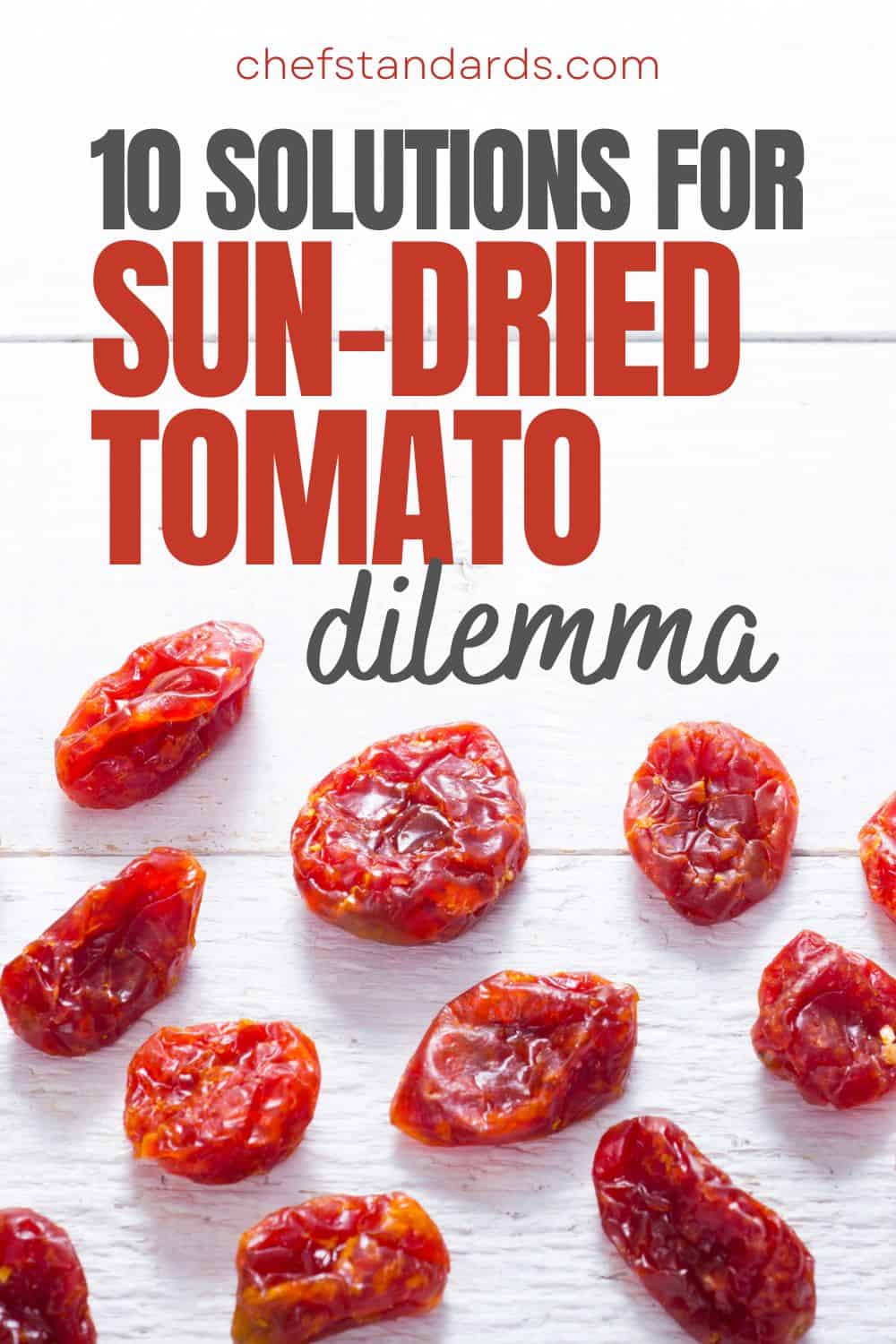Not only are they becoming one of the most important staples of many kitchens because of their intense flavor and chewy texture, but they are also quite nutritious, containing a wide range of vitamins, minerals, and antioxidants.
Tomatoes dried in the sun are the ingredient that every chef and home cook would want to add when a recipe requires some extra flavor punch.
However, sometimes this is not possible.
Fortunately, you shouldn’t worry because, with a little creativity and imagination, you can easily solve the problem because there is a range of flavorful substitutions for sun-dried tomatoes that will take your dish to the next level.
1. Semi-Dried Tomatoes
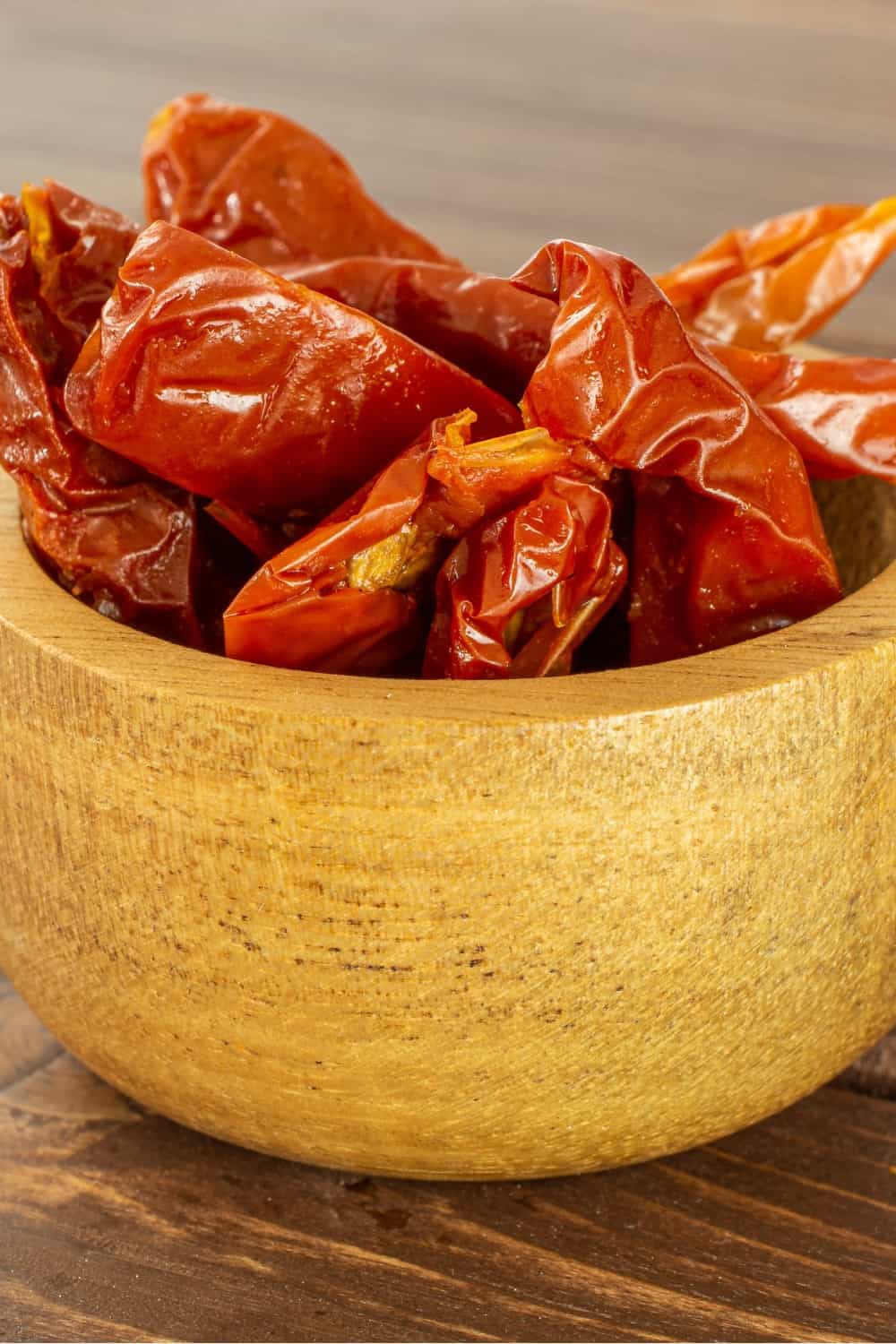
As the name suggests, this version of tomatoes is also dried, but only halfway. However, that doesn’t stop them from being the best sun-dried tomato substitute since, well, they have undergone a drying process as well.
Pros:
• Just like the ones that have been dried in the sun, semi-dried tomatoes have a concentrated flavor that can add depth and richness to your recipes.
• The textures of these two tomato versions are almost the same, as they both are quite chewy.
• In general, semi-dried tomatoes are easier to find than sun-dried tomatoes in grocery stores.
Cons:
• Since they are not fully dried, semi-dried tomatoes have a higher water content which may affect the texture and taste of some dishes that require sun-dried tomatoes.
• Semi-dried tomatoes are sometimes more expensive than their sun-dried counterparts.
• Because they have a higher water content, semi-dried tomatoes are more prone to spoilage, so they may have a shorter shelf life. However, they still last longer than fresh tomatoes and cherry tomatoes.
How To Use Them As A Substitute:
Since they are quite similar, there is no need to do a lot when substituting, but there are some little adjustments you need to make.
Although very similar in flavor, semi-dried tomatoes are slightly sweeter but less intense. Because of that, you will need to adjust the amount in your recipes according to your preferences.
Also, semi-dried tomatoes have a higher water content, so you will need to reduce the amount of liquid in your recipe or cook the tomatoes a bit longer to get rid of the excess water.
Finally, you can use semi-dried tomatoes in similar recipes and those may include pasta, sauces, salads, pesto, pizza toppings, and sandwiches.
2. Canned Tomatoes

Unfortunately, they are not as good as semi-dried tomatoes because they don’t go through the same dehydration process, but they can be a decent sun-dried substitute due to their similar flavor.
Pros:
• Since their base is also tomato, it is logical that they have a similar flavor profile, i.e. a combination of sweet and tangy flavors.
• Canned tomatoes are highly available at most grocery stores, so they may be easier to find than sun-dried tomatoes.
• Aside from being more available, canned tomatoes are also less expensive, so they can be a more budget-friendly option.
Cons:
• Since canned tomatoes have a much higher water content, they may not provide the same chewy texture.
• Although similar in flavor profile, canned tomatoes tend to be much milder, so you may have to adjust the amount as well as other seasonings.
• Finally, canned tomatoes have a shorter shelf life, especially once opened.
How To Use Them As A Substitute:
There are some adjustments you need to do when substituting the right way and the first one is to drain the tomatoes.
You will do this because canned tomatoes have a much higher water content and you don’t want your dish to end up being watery.
Since they are milder in flavor, you will also have to add a higher amount of canned tomatoes to your recipe, and you can also add some seasonings to compensate for that.
The general rule of thumb is to use ¾ cup of canned tomatoes for every ¼ cup of sun-dried tomatoes in the recipe.
You will also have to cook them for a longer period of time because that will help to reduce the water content and concentrate the flavor.
Unlike semi-dried tomatoes, the canned version can not be used in many recipes.
You can add canned tomatoes instead of sun-dried in pasta and pizza sauces, as well as soups, but not in salads and sandwiches where the chewy texture of sun-dried tomatoes is desired.
3. Tomato Paste

This is one of the most popular ingredients in Italian cuisine where it is mainly added to pizzas, but it can also be used as a substitute for many ingredients, including tex mex paste. It can also be used as an excellent substitution for sun-dried tomatoes.
Pros:
• Tomato paste has a deep and concentrated flavor, which can be desired in some recipes that require sun-dried tomatoes.
• Tomato paste has a longer shelf life than sun-dried tomatoes, i.e. if stored in the pantry the right way, it can last up to several months.
• Tomato paste can be found at almost any grocery store or supermarket and it is also less expensive than sun-dried tomatoes.
Cons:
• The most obvious difference between these two is their texture, i.e. tomato paste has a thick and smooth texture, which may not provide the same chewy texture as sun-dried tomatoes.
• Although it has a similar deep flavor, tomato paste is less sweet, so you may need to add sugar or some other sweeteners to achieve the desired flavor.
• It also has a higher water content, which may make some dishes more watery.
How To Use It As A Substitute:
Since tomato paste is very concentrated, you will need to use only a small amount to achieve the desired flavor.
It is best to use 1 tablespoon of tomato paste for every 4-5 sun-dried tomatoes.
Also, my recommendation is to add less sugar or some other sweetener to achieve the desired level of sweetness. You can also add herbs and spices to enhance the flavor.
Use tomato paste to make pasta or pizza sauces, tomato soup (one of the best sides for sandiwches), casseroles, curries, or stews; you can also use it as a base for marinades by mixing it with olive oil, vinegar, herbs, and spices.
4. Tomato Sauce
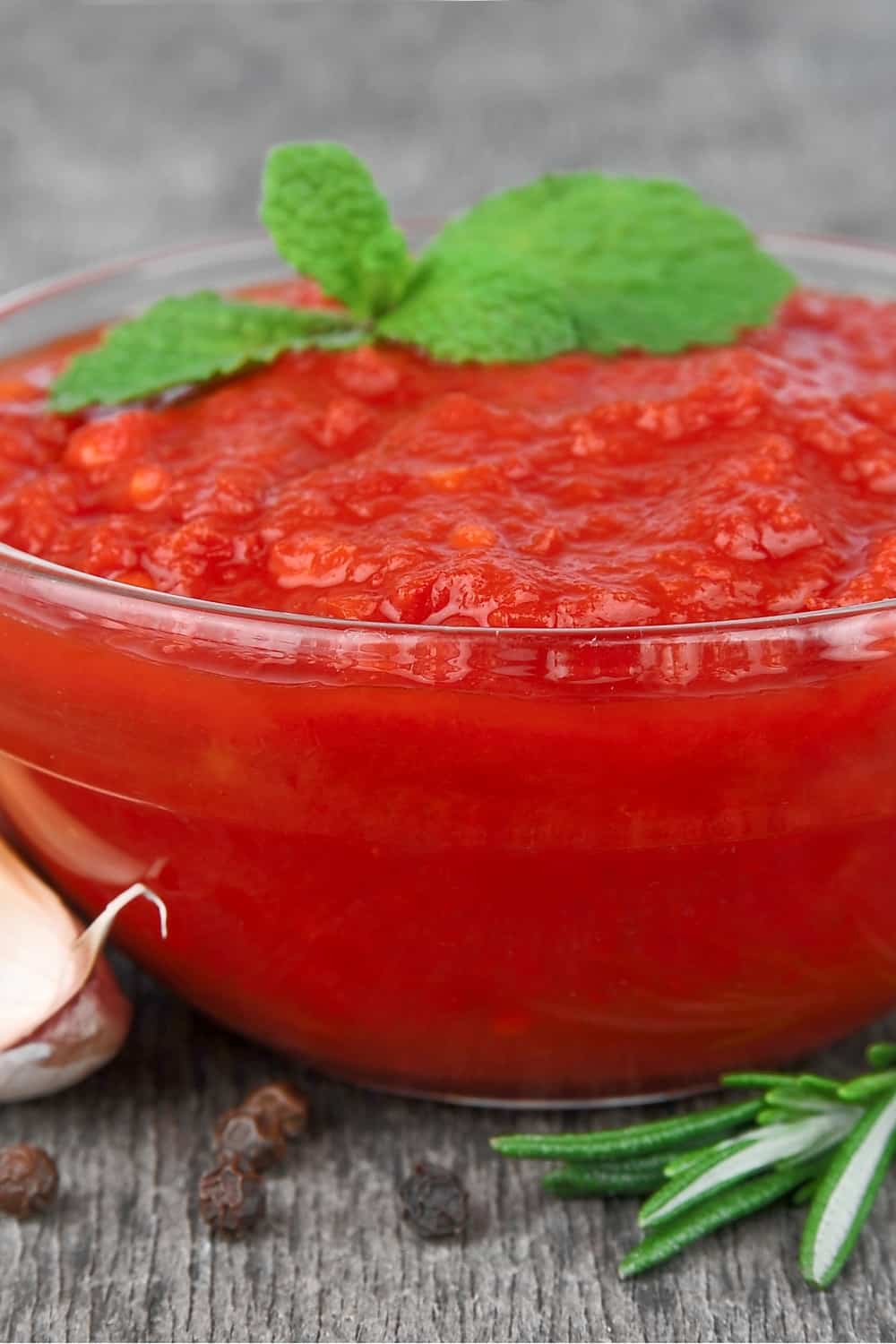
If a thick paste is not your thing, you can try the sauce made from tomatoes and you will achieve similar results. Tomato sauce can be a great substitute for sun-dried tomatoes, but you need to consider a few important things.
Pros:
• These two tomato products have very similar flavor profiles and that makes tomato sauce a suitable substitute in many recipes.
• It is much easier to find tomato sauce on the shelves of grocery stores and supermarkets.
• Aside from being more available, tomato sauce is also a cheaper alternative.
Cons:
• Sun-dried tomatoes have a more concentrated flavor, which can affect the overall flavor of your dish.
• It also has a higher water content, which can mainly impact the texture of the final dish.
• Tomato sauce usually contains some other ingredients, including sugar and salt, which can change the original tomato flavor and influence some other things like nutrition.
How To Use It As A Substitute:
Since it is less concentrated than sun-dried tomatoes, it is best to use it in higher amounts.
The general rule of thumb is to use ½ cup of tomato sauce for every ¼ cup of sun-dried tomatoes.
When using it in a dish, you must remember that it has a higher water content, so you will add less liquid to your dish to avoid ending up with a watery end result.
Since the texture of tomato sauce is different, my recommendation is to add some chopped nuts or other ingredients to help recreate it.
You can use tomato sauce in pasta dishes, salads, pizzas, sandwiches, and casseroles.
5. Fresh Tomatoes
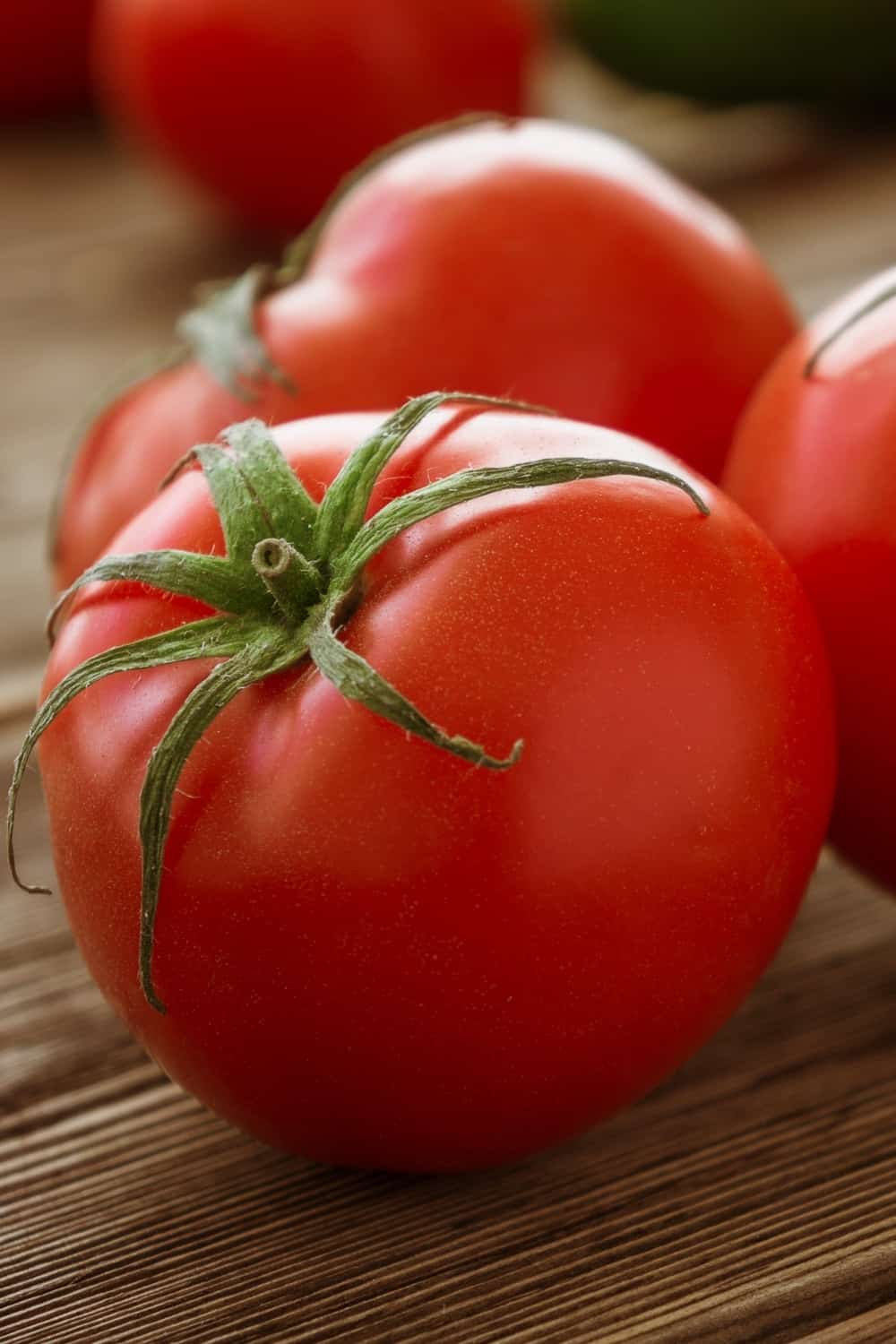
I think that this is the most obvious alternative to sun-dried tomatoes because, well, if there weren’t for fresh tomatoes, there would not have been sun-dried ones either. So, if you are looking for a fresher and less intense version, this one might be for you.
Pros:
• Fresh tomatoes offer a subtle and refreshing flavor, which can be a nice contrast to the more concentrated flavor of sun-dried tomatoes.
• Fresh tomatoes are more available and you can find them in almost any grocery store and farmer’s market.
• They are also less expensive than sun-dried tomatoes.
Cons:
• Although they are more subtle and refreshing, some recipes may require a more concentrated flavor which fresh tomatoes just don’t have.
• They also have a higher water content, which can affect the overall texture of your dish.
• Fresh tomatoes are more perishable than those dried in the sun, so you may have to use them more quickly or store them properly to prevent spoilage.
How To Use Them As A Substitute:
The right way to use fresh tomatoes as a substitute for sun-dried versions really depends on what you want.
If your intention is to mimic the flavor of more concentrated sun-dried tomatoes, I would recommend you choose ripe tomatoes with deep, rich color and firm texture because those are more concentrated and intense.
You can also roast them in the oven with olive oil and seasonings at 400°F for about 20-25 minutes until they are slightly caramelized. After that, you can dry them in the oven at the lowest temperature (170-200°F) to mimic the flavor and texture.
If your intention is to achieve a similar tomato flavor and avoid that concentrated flavor of sun-dried tomatoes, use them as they are.
The general rule of thumb is to use half of the amount that is required for sun-dried tomatoes in the recipes.
If you dried them in the oven, you can use them in all recipes that require sun-dried tomatoes; if not, it is best to use them in salads with the addition of lemon juice to boost the tomato flavor, as well as in sandwiches and bruschetta toppings.
6. Tomato Powder
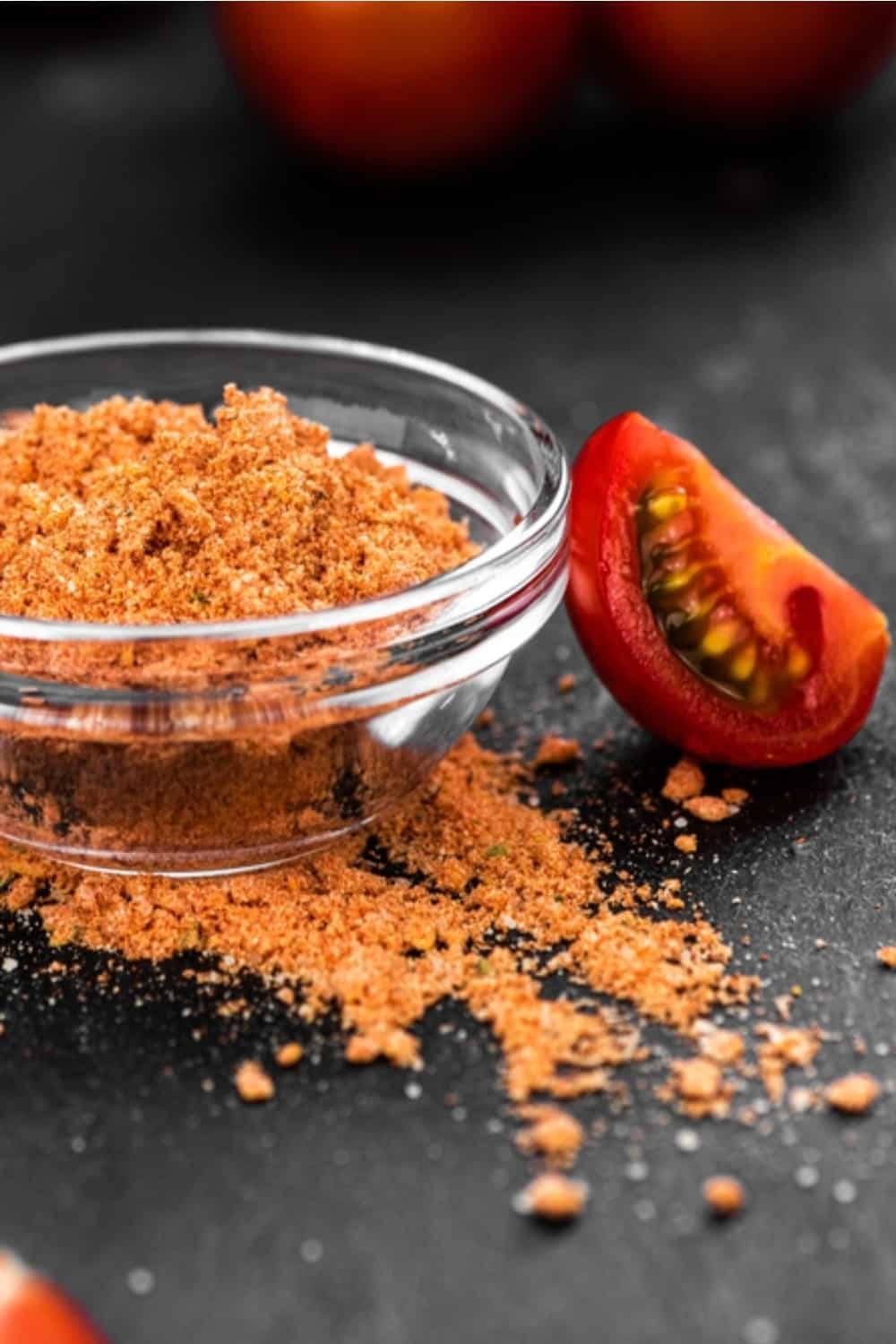
Tomato comes in many different shapes and one of the most popular is definitely tomato powder. It is made from dried, ground tomatoes and has a concentrated tomato flavor that is quite similar to sun-dried tomatoes.
Pros:
• As stated above, the flavor of tomato sauce is similarly concentrated as that of sun-dried tomatoes, which is great for the overall flavor profile of the dish.
• Tomato powder is easy to use and can be rehydrated quickly to make a tomato sauce or paste.
• It is very shelf-stable and can be stored for longer than sun-dried tomatoes, of course, if you store it the right way.
Cons:
• It doesn’t have the same texture as sun-dried tomatoes, so it may not work as well in recipes that ask for the chewy texture of sun-dried tomatoes.
• Although it is similarly concentrated in flavor as sun-dried tomatoes, it lacks the umami and savory notes that come from the drying process under the sun.
How To Use It As A Substitute:
When using tomato powder as a substitute for sun-dried tomatoes, you can use it as a spice in your recipe to add a punchy tomato flavor without any liquid.
However, if the recipe requires it, you can rehydrate it by mixing it with warm water and letting it sit for a few minutes until it forms a paste or sauce.
You can also add some seasonings to mimic the exact flavor of sun-dried tomatoes.
When it comes to the exact amount, you can use the equivalent amount of tomato powder in your recipe.
Tomato powder will thrive in pasta and pizza sauces, tomato soups, stews, and casseroles, but you can also sprinkle a bit on your favorite salad to add a punchy tomato flavor.
7. Tomato Puree

A similar alternative to tomato paste and sauce, tomato puree is a tomato product made by cooking and straining tomatoes to remove the skin and seeds. Since it has a fairly intense tomato flavor, it can serve as a decent sun-dried tomato substitute.
Pros:
• The biggest advantage of tomato puree is the fact that it has a concentrated tomato flavor that can be similar to sun-dried tomatoes.
• Tomato puree is a highly available product and it can be found in most grocery stores and supermarkets.
• Aside from the fact that it is highly available, it is also very affordable.
Cons:
• Its disadvantage is the fact that it has a thinner consistency than sun-dried tomatoes, which can affect the texture of the dish.
• Although similarly concentrated in flavor, tomato puree lacks those umami flavors and savory notes of sun-dried tomatoes.
How To Use It As A Substitute:
Tomato puree has a concentrated tomato flavor, but it is still not as concentrated as that of sun-dried tomatoes.
Due to that fact, you will need to add it in a higher amount, i.e. the general rule of thumb is to use 2-3 tablespoons of tomato puree for every 1 tablespoon of sun-dried tomatoes.
You will also have to consider that tomato puree has a higher water content, so you will have to be careful when adding liquid to your dish, i.e. not to overdo it.
It is best to use tomato puree in tomato-based dishes like soups and pasta or pizza sauces, and you can also use it in stews in which a strong tomato flavor is desired.
8. Roasted Bell Peppers
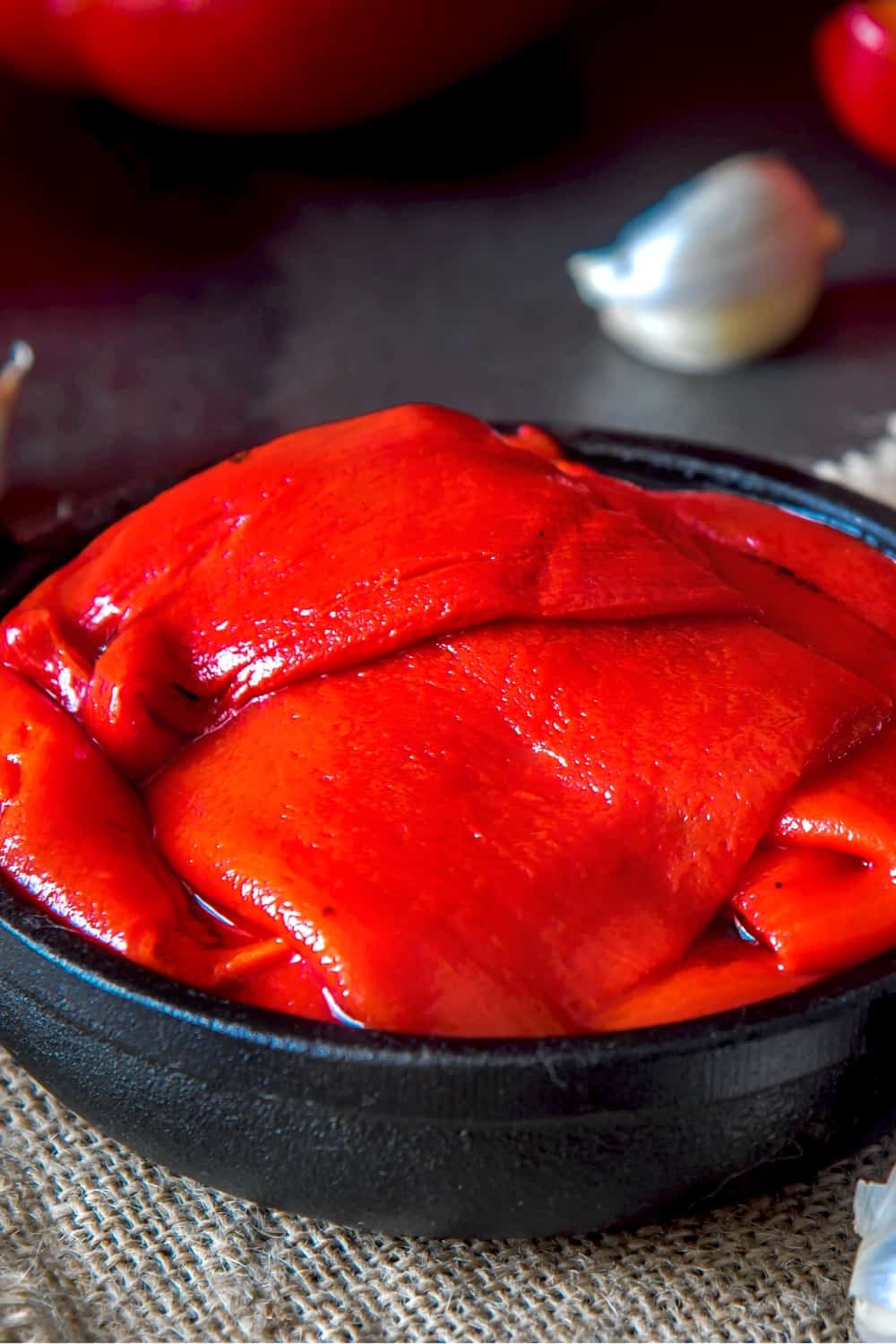
Finally, here is a substitute that is not based on tomatoes, but it can successfully replace sun-dried tomatoes. Roasted bell peppers have a unique flavor profile that makes them an interesting alternative for almost any sun-dried tomato recipe.
Pros:
• Although not the same, roasted bell peppers have a quite similar flavor to sun-dried tomatoes, especially considering the fact that they are entirely different fruits.
• They are more available than sun-dried tomatoes and cheaper as well.
• It is easier to prepare roasted bell peppers and they are quite versatile in the culinary world.
Cons:
• Roasted bell peppers and sun-dried tomatoes do not have the same texture, i.e. roasted bell peppers are softer and can be mushy when cooked.
• Roasted bell peppers have a higher moisture content, which can affect the overall texture of your dish.
How To Use Them As A Substitute:
When using bell peppers as a substitute for sun-dried tomatoes, it is best to use red bell peppers because they have a quite similar flavor, especially when roasted.
You can roast them on the stovetop, in the oven, or using a dehydrator. They are typically roasted over an open flame until their skin is blackened and blistered.
This also intensifies their flavor and makes them sweeter.
Since they have a bit milder taste, you can use a higher amount of roasted bell peppers in your recipe, but if you are okay with that, you can freely use an equal amount as well.
Before using them in your recipe, you can combine them with some olive oil or a sprinkle of salt, basil, garlic, lemon, or thyme, in order to enrich the flavor profile.
Adding roasted bell peppers to salads, pasta dishes, or pizza toppings is your best bet, but you also can not go wrong if you use them as bruschetta topping or in sandwiches.
9. Tamarind Paste

If you are into Asian, Mexican, or Caribbean cuisine, and you have a recipe that calls for sun-dried tomatoes, this paste made from the fruit of the tamarind tree might be an ideal solution. But let’s take a look for more details.
Pros:
• Tamarind paste has a unique flavor profile which is the combination of an intense, citrusy taste and smoky, caramel-like undertones that can enrich any dish.
• Tamarind paste is quite available and it can be found at many grocery stores, ethnic food aisles, or online.
Cons:
• Although it has a rich and unique flavor, it is also quite overpowering, which is not ideal for some types of dishes, including salads and sandwiches.
• Tamarind paste has a thick, sticky texture that may not be suitable for some dishes.
• Tamarind paste is a quite versatile ingredient, but when it comes to substituting sun-dried tomatoes, its usage is quite limited.
How To Use It As A Substitute:
Tamarind paste has a quite strong sour flavor, so you will need to use a lower amount of it when substituting.
The general rule of thumb is to use 1 tablespoon of tamarind paste for every 4-5 sun-dried tomatoes.
Since it also lacks the desired sweetness, you will have to add some sugar or other sweetener to adjust the flavor.
It is best to use tamarind paste in Asian stir-fries that require sun-dried tomatoes, but it will also work decently in curries, as well as in spicy soups and casseroles.
10. Homemade Sun-Dried Tomatoes
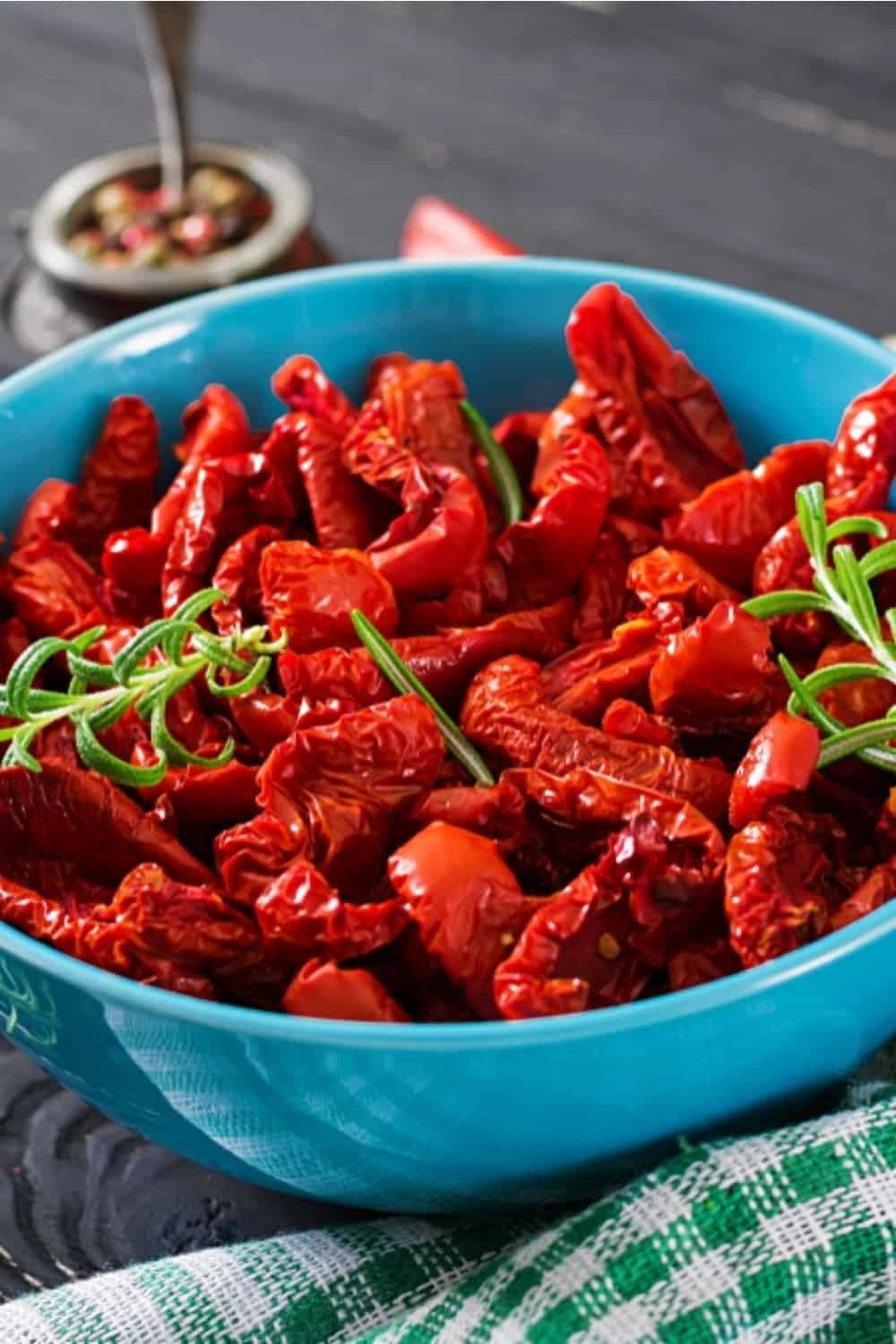
If you don’t have any of these at hand or they just don’t sound appealing to you, you can always make your own sun-dried tomatoes.
And, believe it or not, you actually don’t have to dry them in the sun. All you need is an oven, a little bit of salt, and a few fresh tomatoes. You can use plum tomatoes, but my recommendation is to use sweet cherries or grape tomatoes.
Now, you can start this simple process.
• Preheat the oven to 275°F (135°C).
• Slice your tomatoes in half and scoop out seeds and soft flesh.
• Place them on a baking tray and add a sprinkle of salt.
• Cook them for 1-2 hours until they are dry.
• Once they are done, store them in an airtight container or in a jar with olive oil.
As you can see, the process is quite simple and your tomatoes don’t even have to see any sunlight.
